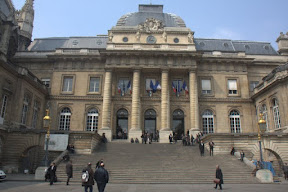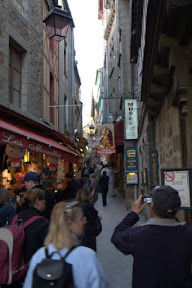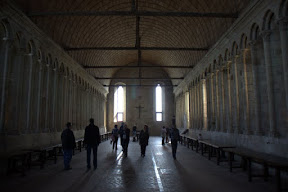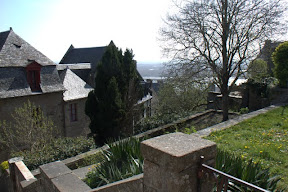I have a new love…
…and her name is Burrata. No, it is not a pastry. (Shocking, I know). It is an Italian cheese.
No, we’re not in Italy, but one of the wonders of Paris is the accessibility of all things fabulous from elsewhere in the world.
Burrata is creamy, salty, and tangy, all at once. It was delivered fresh from Campania, Italy to the Italian food co-op in Paris’s 5th arrondissement today. It was worth the hour long walk to the co-op and the blatant ridicule and laughs the man behind the counter and those in line shared at my expense during my awkward efforts to order. Yes, it was that good.
In Which We Storm the D-Day Beaches and Besiege Le Mont-Saint-Michel
This past weekend, we hopped a train to Northern France with Matt and Brad to check out the Normandy region of France. Our first activity was to pick up the aqua box otherwise known as a Renault Kangoo.
 |
| From Weekend in Normandy |
The ‘Goo was one of the most atrocious cars I have ever seen, but it had tons of room and it served us well. The ‘Goo is a manual, so Sean took a couple of practice laps around town before we set out on the highway. It’s like riding a bike, Sean told us. To his credit, he only stalled once. In some of the towns, the roads were so narrow that the stone buildings jutted out in into the roadway, but Sean informed us that the ‘Goo felt like she was on rails.
We headed out to the Gold Beach first, where the ships the Allied forces purposely sank to create an artificial harbor on D-Day were still protruding from the water.
We then drove through the French countryside to Omaha Beach, which is one of the beaches where the American platoons landed on D-Day. There, we explored the memorial museum set up by the United States on the land granted to the country by France. Following the museum, we headed to the cemetery, where thousands of crosses and Stars of David were perfectly aligned in rows, marking the graves of 9,387 American soldiers who died in France during World War II. The orderly rows, with the ocean waves in the background, belied the chaos that occurred on D-Day.

The hometowns of the soldiers were listed on the markers. It was all too easy to find graves of men from Pennsylvania. I was reminded of the line in Our Town where the narrator observed that many times soldiers fight for the freedom of people they’ve never met in places they’ve never seen.
We then wandered down to the beach itself, where two German bunkers still remain. Looking at the peaceful coastline, it is hard to imagine the fighting, death and destruction that occurred just over sixty years before.
From Omaha Beach, we headed to Pont du Hoc, a sharp cliff that American Rangers had scaled while under fire on D-Day to reach and destroy German weapon stockpiles.
You were able to climb in and out of concrete crevices and holes, many of which were still lined with the original barbed wire. In America, a site like this would be fenced off from the public. In France, only the deepest holes were blocked off, and by blocked off, I mean that the government evidently inserted some newer barbed wire to deter people from going near the area.
The D-Day beaches, a significant part of World War II, were interesting to see with our own eyes. Perhaps it is because any of the war-torn sites in the United States happened many years before our lifetime or the lifetimes of our family members, with the exception of Pearl Harbor.
However, we all agreed our favorite part of the trip was visiting Le Mont Saint Michel. Mont Saint Michel is an island. The first building on the island was first inhabited in 708. The Benedictine monks settled into the abbey at the top of the mountain in the 10th century, while the village grew up below its walls. The abbey and village are still here today, which is almost incomprehensible. What is further incomprehensible is that the island was under siege from the British for 30 years during Britain and France’s 100 year war – almost our whole lifetimes.
We could see Mont Saint Michel way in the distance before we arrived in the town of Saint Michel. There are no other way to describe it other than majestic. In the late day fog, it looked like something from Disney Land, soaring high above the rest of the land. The island itself raises high into the air. When you got up close, you could see lots of old stone buildings jutting into the air around the island, culminating in the giant abbey at the very top. On the land leading up to the island, sheep graze in the grass, most of whom barely paid attention to us as we photographed them.
I was expected Mont Saint Michel to be a cluster of old, unusable buildings, so I was surprised to learn that there are approximately 51 inhabitants on the island. When we entered through a stone gate at the bottom of the island, I was even more surprised to see what looked like a quaint little European town, complete with gift shops, creperies, brasseries, a post office, and a hotel.
We followed the narrow, rambling cobblestone path up the hill. Periodically, one of us would exclaim, wow. This is really cool.
Up the hill, past the buildings, we climbed endless amounts of stairs, until we finally reached the abbey. At the very top, light streamed through the windows of the otherwise dark chapel.
We then wandered through the stone rooms, each one more fascinating than the next. We never did figure out how someone seamlessly integrated modern technology into the building.
I am sure we will be saying this a lot on this trip, but le Mont Saint Michel was one of the coolest things we’ve ever seen. It is one of those places where it is impossible to capture the awe you feel when you see it up close, despite the hundreds of photos you take.
The True Red White and Blue
I love photography. Photography was one of those things I always wanted to learn more about, but since I didn’t get around to it before we left, taking pictures mostly on the auto setting will have to do. Since I am not an expert photographer, sometimes I settle by being in awe of other people’s pictures. When we learned that the Maison Européenne de la Photographie was free Wednesdays after five, we decided to go.
My friend Tony always says I need my art spoon fed to me. I don’t disagree with this statement. So I was a little creeped out by an exhibit that demonstrated the photographer’s clear obsession with horses, and I didn’t know what to make of the exhibit with posed pictures simulating murder accompanied by punk music and giant bullets. But I really enjoyed, and understood, the exhibit featuring the work of the Swiss photographer Michael von Graffenried. von Graffenried is a photojournalist of sorts. The exhibit covered a range of his work, including photos from his year following Peter and Astrid, two Swiss herion addicts. These photos were shown in the park where junkies hung out upon the project’s completion. There were also photos from his time covering people in Algeria, and some from his time covering people in Cairo. The Cairo photos were also displayed on rooftops in the projects.
We were amused by his photos from a nude camp. The photos of a naked people mowing the grass, playing tennis, riding a bike, and other such activities made me think of the Seinfeld episode when Jerry told George that some activities just shouldn’t be done naked.
We also were intrigued, and horrified, by his photos from New Bern, North Carolina. New Bern is the sister city to Bern, Switzerland. von Graffenried spent some time observing life in New Bern, outside the big cities. Life in New Bern included men completing drills at the army base, a boy playing basketball, the mayor in a taxi, religious signs outside a church, a not-so-attractive stripper leaning over a man at a strip club, and a myriad of other pictures. The horrifying part was a picture depicting people walking down a main street. One of those people was a woman, wearing nothing but a white bikini and wedge flip flops, with her gut hanging out and cell phone strapped to her bikini bottoms. That’s America right there, on display for all of Europe to see.
Interestingly, despite free press in America, the newspapers in New Bern refused to reprint his photos, and he experienced a lot of flak for the exhibit at the time. Yet unlike the photos in the murder exhibit, these were not staged – all he did was take pictures of what was happening around him.
French Justice
I was one of those people who wanted to go to law school – to fight for justice, of course – since I was young. After graduation, I quickly realized that I wasn’t sure if I liked the actual practice of law, and that’s something I am hoping to resolve during this year away. But the law still fascinates me. I was browsing the blog SpottedbyLocals.com, and came across a suggestion to visit the Palais de Justice (i.e., the courthouse) while in Paris.
 |
| From Paris by day |
The blog mentioned that everything would be in French, but it was interesting to observe the rituals nonetheless. A central principle in France is for the legal proceedings to be public, so we could just slip into courtrooms to watch (much like many proceedings at home). I proposed the idea of visiting the courthouse to Sean. Although he joked that we could probably tag along with Matt to work and observe how computer programming is done in France, he agreed to go.
The law of France is based upon a civil law system, a concept I vaguely remembered from my law school days. Damn, I thought, I should have taken comparative law. This is a thought I’ve had many times over since we started this trip. I was never interested in any international classes during my schooling, preferring to learn about American politics and law instead. At the time, international or comparative classes seemed to not be relevant in my life. (It is somewhat ironic, and unfortunate, that later in the year after I took an International Terrorism class in college – one of the few international classes I did take for my political science major – September 11th happened. Suddenly, the class was all too relevant in a very real way.)
From what little I do know, the English-based legal systems are centered upon common law, where judicial precedent is everything. By contrast, the French legal system is a civil law system, where a civil code serves as the foundation. Juries are not common in France, and judges serve very active roles.
This was played out in the several court proceedings we observed one Wednesday morning. One of the courtrooms we ducked into was a criminal court room. As I suspected, all of the courtrooms were pretty grand, a far contrast from the bland administrative courtrooms I’ve seen at the Allegheny County courthouse at home. The judge, decked out in a black robe with a white bib, sat up high on a bench, surrounded by many people who I assumed were the court clerks and staff. At least in this proceeding, the lawyers played an inactive role, sitting down to the left and the right of the bench. The lawyers wore the same formal robe as the judge, but I saw many of them with jeans peeking out from underneath. The defendant stood solitary before the judge. From what I could gather, the proceeding appeared to be a criminal sentencing. I had no idea what the judge was saying, but it was clear that she was not happy with the defendants’ conduct. She reemed him out in high pitched French for several minutes, then began reading something from a book at her bench. I wasn’t sure what crime the defendant was accused of committing, but it was clear it was something worthy of a tongue lashing.
 |
| From Paris by day |
During our visit to the courthouse, we also checked out a proceeding in the court of appeals. Inside the courtroom, three judges sat on a bench, with one lawyer standing speaking in front of them. At one point, the lawyer sat down, and an individual got up to speak. I couldn’t figure out what was going on, because generally only lawyers spoke to the judges in the appellate courts in the United States. I also couldn’t figure out what purpose large glass walls on each side of the courtroom served. It appeared to be some sort of security chamber, with microphones, but I could not tell how they were used. While the lawyer and the lay person spoke to the judges for a short while, the judges clearly dominated the proceeding. We watched the middle judge speak to the lawyer and lay person at length. I never was able to figure out the context of the proceeding, but it was interesting to observe nonetheless.
 |
| From Paris by day |
Unlike many of the courthouses at home, most of this courthouse was deserted, except for a line of young, eager, fresh-faced individuals who appeared to be new lawyers about to be sworn into the court.
I couldn’t help but notice, for whatever it is worth, that like at home, most of the criminal defendants were black and the judges and lawyers were white. Admittedly, this sample size was very small, so I am not sure if it is representative.
Visiting the courthouse was fascinating, at least for me, and I decided I would try to repeat a visit to a courthouse later on in the trip.
In which we are trapped in Europe by volcanic ash.
The best thing about Paris so far, besides the baked goods, is the fact that our visit coincides with the trips of some of Sean’s friends from his old job. (I say that like it is a coincidence, but our trip to Paris came into being precisely because they are here). This is not just because of the free lodging in a big, airy, light-filled apartment complete with a hair-dryer and a washing machine (albeit a confusing French washing machine). It is also because it is fantastic to be able to socialize and speak English to someone other than each other.
Matt, Brad, and Velin are all “regulars” in Paris by now, so they’ve shown us some of Paris’ finest sites, including:
(1) The BHV, a French department store, where we bought an air mattress (It only took four tries to inquire where an air mattress might be located. Each salesperson pawned us off to the next floor. On the 3rd floor, we were told it was the 4th floor. On the 4th floor, we were told it was the 5th floor. On the 5th floor, we were told it was the 6th floor. We finally ran out of floors, but luckily, we finally found the air mattresses. Ours comes with a fun and funky backpack for sleepovers (or so we are told on the box). Here we are, sampling the merchandise, much to the amusement of the French people:
| From Paris by day |
(2) A Grec eatery, where we dined on Super Ass Grec, accompanied by a Marathon Greek pilsner (which we can only assume is a Grec I.C. Light);
(3) Paris nightlife, where we learned that we have a friends, even outside of Pennsylvania.
| From Paris by night |
| From Paris by night |
Because we are determined to mooch off of hang out with our friend Matt as much as possible, we have decided to stick around Paris for another week. When I say “decided,” I mean that by procrastination and inertia, we didn’t book our plane tickets to Morocco until today. We fly out April 26, provided that the volcanic ash cloud dissipates by then. Apparently, the airspace above Europe is being besieged by volcanic ash, so we couldn’t leave Europe if we tried. Or at least, that’s what we keep telling Matt.
















